Shaman: Sage & Guide of the wilderness and edible/medicinal plant world
What's up Hive!
On my last post, I tallied resources to explain and put in practice different spiritual practices and the why and where it may come from or the discipline required to bring healing to their tribesmen (people). Some more extreme than others but you know me, if I cover a reading topic, I try to cover it from many angles. Much of the psychology has been misunderstood for ages while other practices are perfectly adequate for the everyday person on the quest to mindfulness and personal awareness can apply to every day life.
I covered from the Shaman spirit world journey via dream interpretation, altered states of consciousness natural or drug induced all the way to a more normal person consumable helpful information as their finished product and many things in-between but that isn't their only traditional function in society. Besides their spiritual priesthoods, their task is also to know and observe nature and know everything about it including the most subtle of movements along with noticing the unnoticeable to most. A human brain database storage of the plant world and it's secret knowledge. Most of us go to the supermarket for our food or the drugstore for our medicine but that wasn't always the case.
They contained some of the most sacred knowledge of all time to the secrets to life and it was nothing spiritual in that regards, nourishment based on the times of year, how to preserve what, different life cycles, what was to come based on abundance or lack thereof and what to prepare for, everything had a tell tale sign and they knew them all. Perhaps not the exact science behind things but at the very least the repercussions of what they could interpret from their environment's being or subtle reaction.
Wild Hazelnuts, the prickliest tasty treat in the north. We have to get to them before the squirrels do and they are not quite ripe so the green peels are a pain but leaving them in a burlap sack in a cold room in the peels they can last until Christmas without being stale and once the peal is dried and brown, it's much easier to peel. If I had to pick between fresh and cured, the taste is worth the green peel cacti-like attack on your fingers.
Luckily, I have the supermarket like everyone else but their is always the possibility that one day, we may find ourselves without. I hope it never happens but having a few resources on hand to be able to identify the different edible and medicinal plants in the event. As a little kid, I used to walk in the field and eating random weeds, flowers and berries. I didn't necessarily know what they were at the time, just they tasted yummy and I knew what to eat somehow and I had a visual list of what I called snake food.
I never would have been able to tell the name of any of them tho. I always responded with, stuff I remember from another life and carried on eating weird field things unharmed like nothing, the adults were a bit weirded out but the reason to be there in the first place was to pick weird stuff in the bush anyway. That's the kicker, I never ate anything that made me sick in that way. As an adult, I checked everything and it was all indeed edible!! Even some of the snake food.
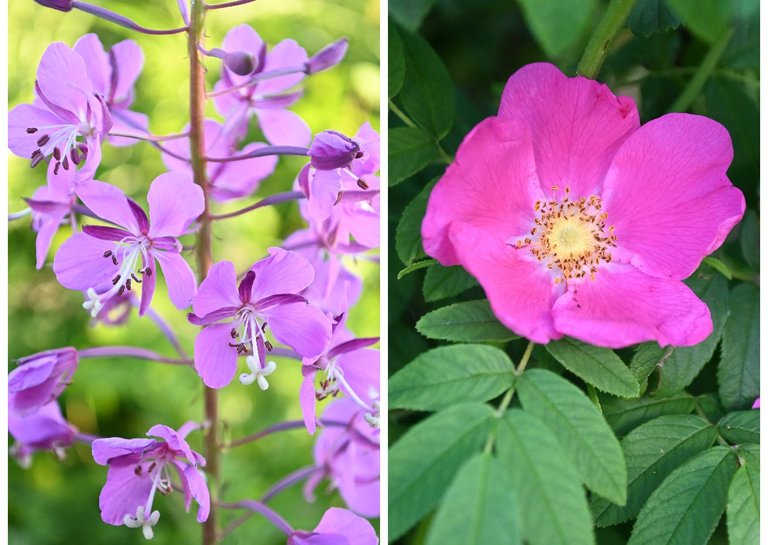
On the left, fireweed, common where there has been forest fires or dead beach wood, a species that thrives where wood decays. Both the flower and the stalk are edible, the flower has a sweet nectar and the stalks can be boiled to yield a similar taste to green beans crossed with asparagus. On the right, Alberta Wildrose, it's our provincial flower and in abundance. It has several uses mentioned later in this post.
I didn't have the internet or a computer to figure it out either, it wasn't a thing yet. We still had to go to the library but chances are not the type of information the majority requests so resources were limited on the subject given I lived in a small Catholic community parish in the Appalachian Range of like 500 but less 1000 ppl at the most. Our school had like 80 students, Access to many luxuries was limited. So was money and long trips to the supermarket, eating out of the woods aka foraging was more affordable.
We still ate store stuff but it was half and half. A lot of wild food too, tastier and more common than some would assume but some might be a little off from today's everyday diet. Getting a McDonalds was like a once a month treat! Knowing what I know now, I probably didn't miss out on anything at all on that front but somehow back then, it was a big deal. 🤣
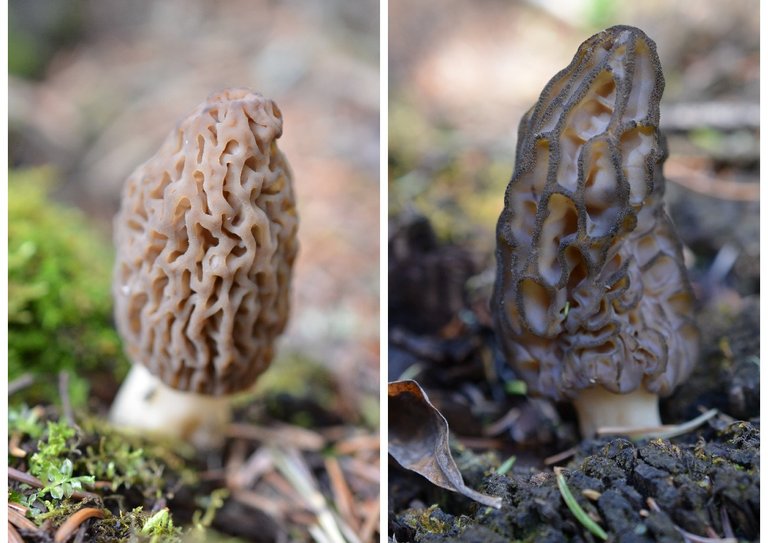
Morel Mushrooms, another species that has a symbiotic relationship with wood decay, while visiting a friend, we were taking a hike in the woods near his place and we found a whole Ziploc freezer bag full along the way. This stuff is an expensive enough delicacy to buy. We fried them in butter and garlic as a side with a nice locally grown steak from a farm down the road and mashed potatoes.YUMMY!
Much of my edible wilderfood knowledge was passed down from living ancestors picking various berries and other plants as they got in and out of season to fill a large freezer full along with shelf full of Mason jar canned goods , jams...berries as many ways as one might think. Of course the seasons for each were short we enjoyed our fill of the fresh natural bounty. Picking, cleaning, canning, making all the jams and other goods that would need to last for the winter took a lot of time and prep. We had 2 large gardens for the more common vegetables and a small poly hothouse for plump tomatoes. Made out of old salvaged wood and pretty rickety looking but it worked so...
Adults took part in the canning but I was more often than not involved in doing my share in the other tasks. we had a mental list of all the near-by abundant strawberry, blueberry, raspberry patches all the way to abandoned apple orchards, hazelnuts, fiddle heads, wild mint, flower petals and other wild vegetables or look alike. Most things we buy at the supermarket have a wild version that taste similar, just might not look the same. One example is Burdock roots are like wild carrots and even what you harvest, the root is so deep that it just breaks off and grows itself back.
Cattails are natural corndogs, take a bite of the brown end I promise you'll love it!! JK 😂. Despite me trying to punk you a little, they have a core under the hard shell near the root that once pealed and cooked are similar to bamboo shoots. Wild Rose petals and Rosehip often turned into tea or eaten the petals fresh in salads. Rose water has also been known since the beginning of time for it's health benefits both internal and external as it continues to be used in most high end beauty products for it's amazing antioxidant properties.
The forsaken monstrous DANDILIIIIIIION Quick get the weed killer! Nope. Nope. Nope. Not on my lawn as small as it may be. We even tried to uproot them from Hive when they were spreading too far and wide in bad crooked blurry photo of the spammy days...What's the beef with this miracle of a flower that needs so little that it even grows in concrete. Every single part of the plant is usable and edible, from root to flower. Here in Alberta, we even have wine that has become quite popular locally that they run out of flowers. The white stuff that comes out of the broken stem is like polysporin, both in antibacterial properties and pain numbing force of modern day Tylenols. The roots can be roasted and made into a coffee like replacement tea drink. The leaves are good salad bitters, I promise you, they already are in the bagged salad mix most buy before you go EWWWW
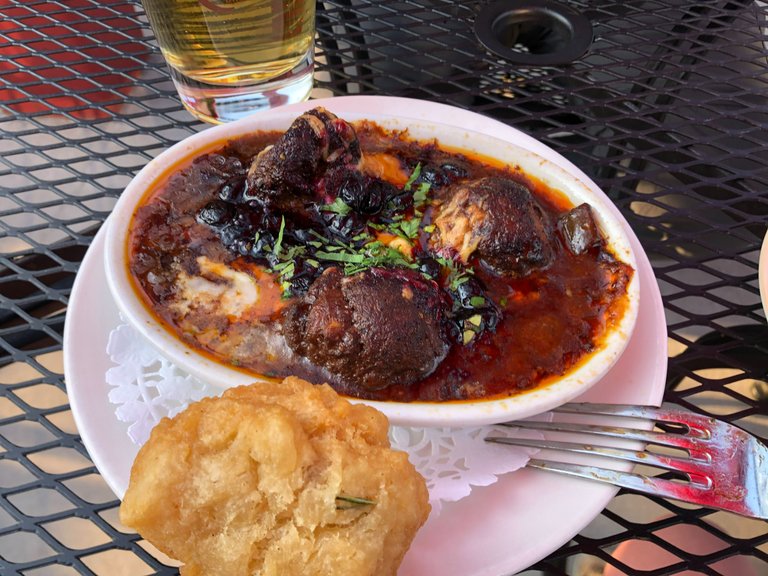
Buffalo aka Bison meatballs served in gravy and Saskatoon berry and bannock, a no yeast fry bread based on Indigenous traditions. The dish is from Fiddle River in Jasper National Park.
In Alberta, we have an abundance of wild sage to use as incense or as a spice, wild asparagus, wild onions and of course the locally famous SASKATOON BERRY. These berries grow on tall enough trees and they are abundant. They find their way into pies, jams even on our plates in fine dinning experiences both in sweet and savory dishes often being paired with an array of wild local meat. A local delicacy and it's worth it's reputation. I never personally went for a harvest yet for some reason but it's been on my bucket list but I do eat a handful off the trees depending on color because some can be bitter, they are better cooked.
I wont list them all that float in the back of my mind but when I walk into the forest, if on crown land, I look for the little hidden treasures, even welcome the backyard weeds. The point of this post is to show how close of a relationship man can have with nature and since this is quite extensive, every wannabe shaman needs a good arsenal on hand to be able to identify and know what's what and just how much we walk by without a thought is actually useful in many ways we have forgotten with our modern ways. Not all shamanic knowledge is of the supernatural kind, much of it is very much rooted into solid soil.
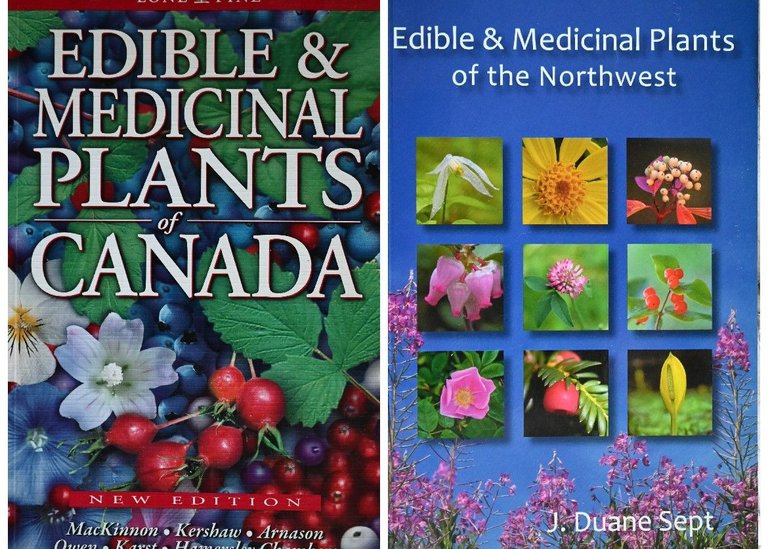
These books I have for you today have been part of my arsenal for quite some time, some for even a decade or more. They were so much cheaper back then! These are natural to my location so each would have to look for similar literature based on their own landscape but this should be applicable to Canada and North-America for sure. Found in most stores from the supermarket, Walmart and any other bookstore, they are jam packed with quick references on hand for places where you just don't have the internet to consult plant profile and potential poisonous look alike. With my photography, I normally have a backpack for additional lenses and to carry one of these fit nicely into a side pocket.

*What I refer to as fiddleheads, on the left is an example of how the information is laid out in the Edible plants of Canada, the much more expansive resource out of the two books with it's over 400 pages of knowledge. On the right is a home made salmon and fiddlehead, Salmon was an abundant resource when I was a kid and our local traditional wild caught food. I now buy it at costco but it's a good landlocked option at an affordable price. For the tasty top, simple, Italian dressing marinade.
The information contained is mostly scientific, climate, properties and proven medicinal uses over the ages. No guessing like the little kid I once was anymore and no woo-woo knowledge, I have finally found my plant bibles I wish I had back then and much safer than eating at random. By the way, thistle was the one that weirded everyone out, the nectar from chewing the petals was really sweet and syrupy... Bees really liked it, there must have known something, I took their word for it, they were right! Ahhh the innocent mind of a little kid. Weird analysis but correct conclusion. I could smell wild mint from a mile away and always found it, I liked chewing on that quite a bit too. Good for digestion.
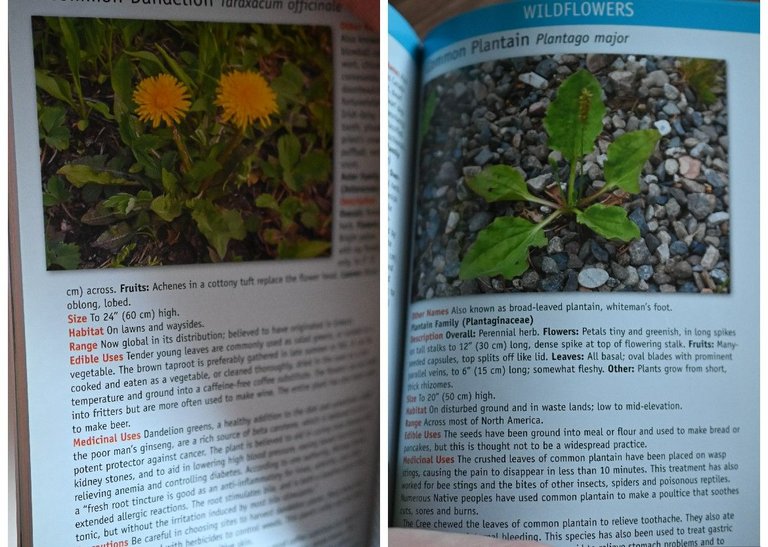
A sample image of the plants of the North-West material layout and the type of knowledge that can be found, this one is light weight in a back-pack and contains the essentials being less than 100 pages compared to the more thorough 400 pages but depending how much weight you are willing to carry. I use the bigger one more for advance study or to reference what I have seen on my hikes or taken photos, tends to stay at home or in the truck.
For an even lighter weight option, various plastic pamphlets are commonly sold especially in tourist shops in the Rockies or Kananaskis. The information found is limited compared to the books but it offers an even lighter weight option that covers the basics especially for the longer hikes, after 20 km, that backpack feels real heavy, the lighter the better. So now you have a sample of resources made for different type of plant explorations and their uses.
While exploring the Rockies in the National Parks, eating from nature is not allowed and a finable offense but species identification is always a fun aspect of photography or just as a stand alone quiet low paced activity especially in mid summer when the wildflowers are in full bloom. The immense variety is spectacular and even short simple hikes can reveal several species of blooms clustered together and send a nature enthusiast on a quest to tap into their own inner shaman and gain plant knowledge. The different terrain and altitudes have their own characteristics and this book is a nice summery of many of the natural gems with the information displayed in a similar identification as the first two books.
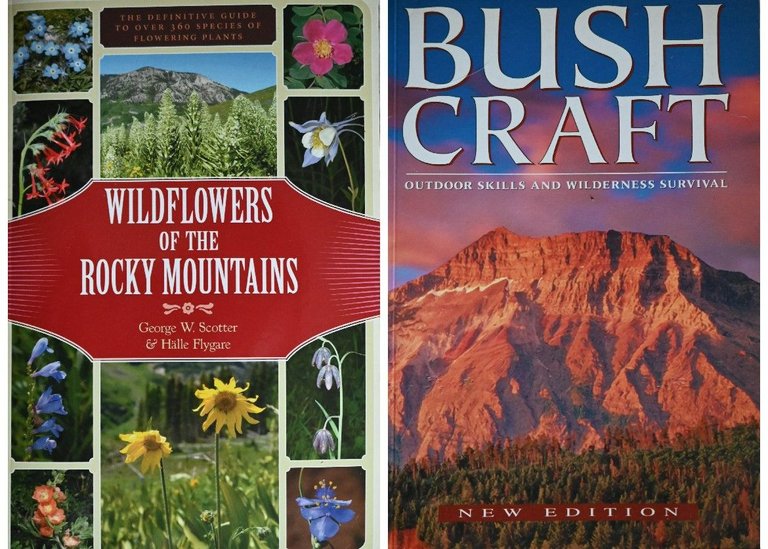
The Bush craft, well it was buy one get one free with the edibles of Canada and the most relevant to my taste that was available, never know when I might wanna learn basket weaving! Don't worry, it's actually useful but I'll get to it in a minute.
Taken at Sunwapta Falls, every summer the trail to the second set of waterfalls is lined with what I call the lemonade flowers. I didn't know what they were at first, just pretty and lemonade colored. The rest of the world calls them columbine but the nickname stuck.
Now for the Bush Craft book, the basket weaving stab wasn't a joke and it is in there but it has much much more. Many basic knowledge and how to's to make stuff happen with just what's around you. I suppose that is a handy book to have if you get lost in the woods and the knowledge within it can make your stay much more comfortable until you get rescued or if you just choose to live there in the wild for a few days. I've done it, I promise I wont judge. Obviously, shelter making and selecting a proper and safe location with different designs based on terrain or climate.

As a teen, I ran away from home to the woods and made my own shelter, I second the needles being warm and smells nice, I insulated it with hay and slept in it overnight in below the freezing mark. Never know you need the book until you actually do...too bad that wasn't in the public library growing up. It's ok, the inner shaman knew. Instincts. Told ya, it's from a different life, I to this day still have no other explanation for my field eating and bush shelter making skills, I was actually good at it and had a whole village built in the forest behind my house as my escape or something to do. hazelnut branches were abundant and regrow easy in the spring so I used to split it and weave it into rope to hold my shelter in one piece.
Many type of trees , barks and other foliage can be turned into rope and other tools along with how to bind things like shelters or protection walls. The book helps select the proper material and how to best modify it into various useful survival items. It's 300 pages covers in extensive details including close up drawings as most of us are visual learners and fits nicely in a back-pack. I highly recommend this book for anyone who ventures in trails especially if a city slicker part time hiker, it's good stuff to know in a pinch that you might not think to ever study. Don't underestimate the forest, it will win every time.
A beach full of fireweed where I took a micro 10 minute rest after a 20 km hike. The area is susceptible to winter avalanches and water run off and erosion as it feeds the glacial lake, the current in the large lake deposits all the debris on this shore turning it into a pretty rocky field of flowers.
Now what about the other two books in the original image? Merlin and the herbalism book? Well I'm in the process of reading a reconstructed Grimoire based on extensive research across Europe folklore and written accounts to transform the information into a fun to read experience full of wisdom. Was Merlin real or Mythical? Doesn't matter, I'm not trying to prove or disprove history or overthink it, Druidism and Shamanism have many similarities since they are both centered around the natural elements and the knowledge within it along with the impression it leaves on the soul.
I'm a quarter way into the book and the songs about trees that are shared inspired me to write this, honor the plant world. I may or may not share more about it until much later and I can make a complete journey with it like Lady Rainbow's trail of books. I like it so far but I'm 100 pages into 400 so I got a bit to go yet. As far as the Herbalism is another grimoire style book covering the history of plant usage during the ages along with folklore and the myths and mysteries that surround them. I didn't start reading it yet so I can't say too much yet besides it's my next read and thought it would fit nicely in the shaman themed posts. It's an almost 500 page read. It might take me a while to read both. I have a few other books in mind to read on the related topic to make a more 360 view. I like legends just as much as the real. A creative mind is a gift.
All right, peace out gang. xox
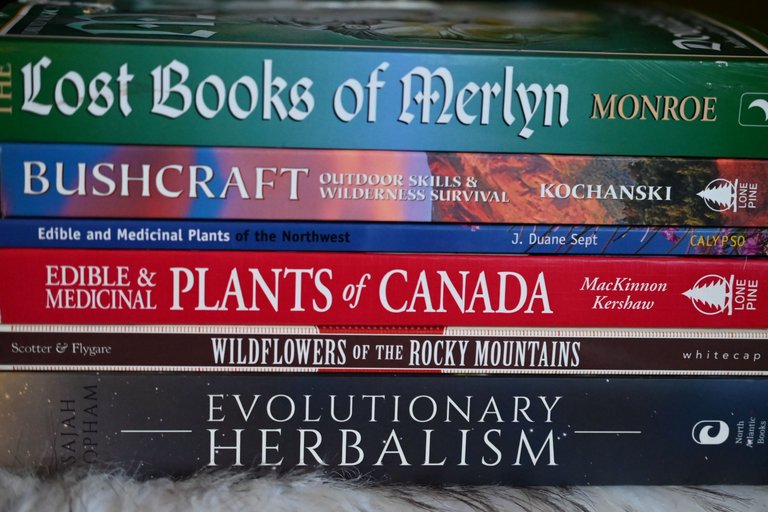

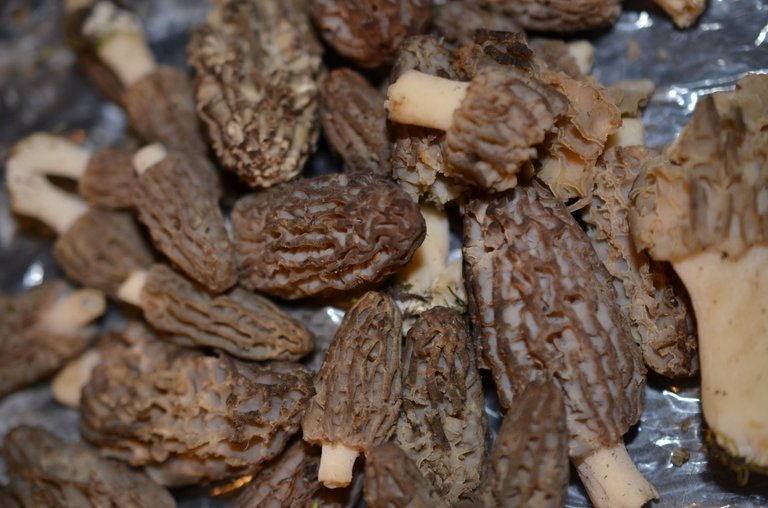

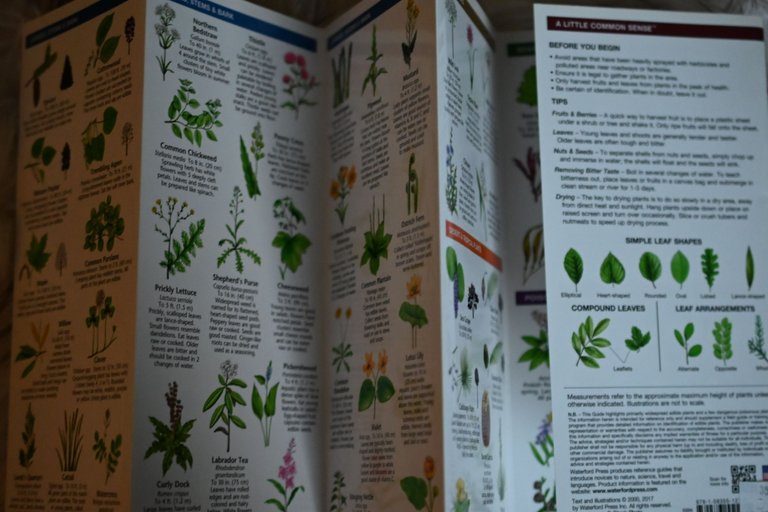
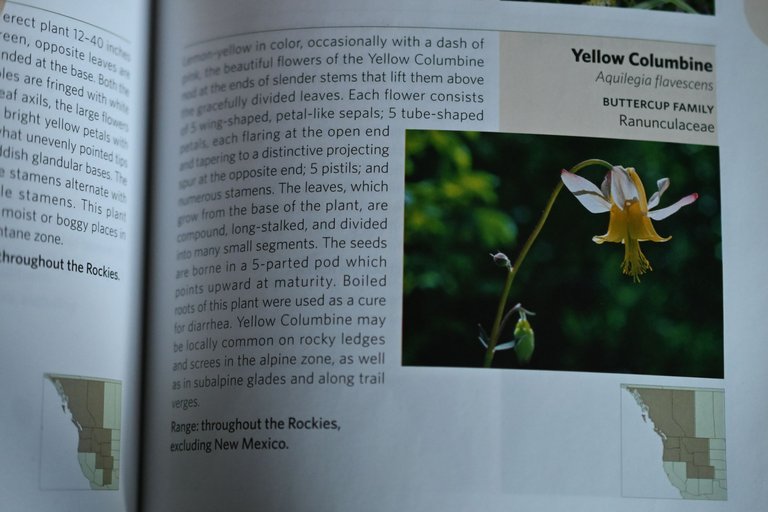
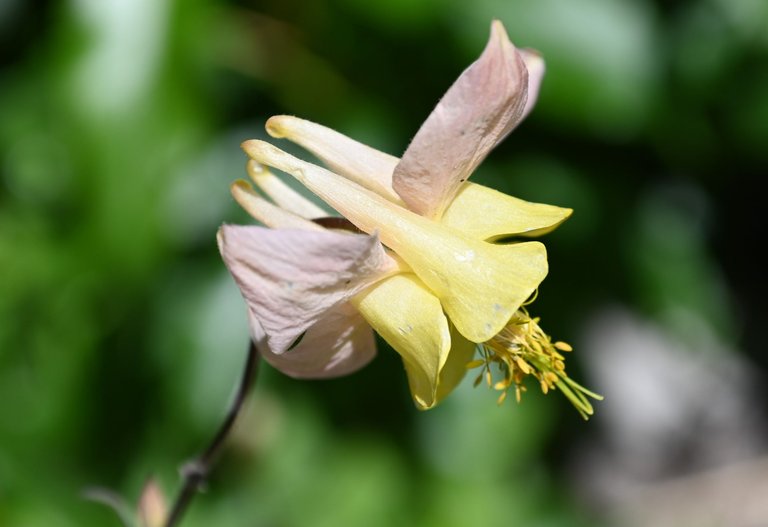

Edible and Medicinal Plants of the NW is a solid buy just in case we lose the internet.
That was my thought! There is a lot of useful knowledge packed in a tiny book.